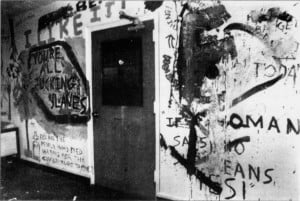
The recent anti-Semitic vandalism of Sigma Alpha Epsilon’s (SAE) fraternity house has left some students shocked at such displays of hate. This, however, is not the first instance of hateful graffiti on campus. Below are excerpts from Daily articles about instances of hateful graffiti from years past.
In 1998, Jessica Mahlab, a student, reported a swastika in East Lagunita basement that has gone unchecked for over a year. When Mahlab reported the swastika, she was told by the Facilities Manager Rich Lang that he would personally paint over the swastika. Weeks would pass without action, and Mahlab would contact Lang’s office again and again, even offering to paint over it herself. Time would still pass without action until Mahlab’s resident assistant, Kim Coleman, went to Lang’s office and asked that she paint over the swastika by noon that day.
“I just forgot to paint it — it wasn’t an intentional delay,” Lang told The Daily. “I had the paint and the brushes available and I told her (Coleman) that if the student wanted to do it right now, she could.”
Coleman then called Lang’s boss, Lynn Glick, and asked that the swastika be painted over immediately. It was finally covered two days later.
Students were dismayed that such a symbol could be on display for such a long time.
“It’s disgraceful that Stanford students can walk by these, and other offensive graffiti, and not take any action,” Mahlab said.
This incident caused great outrage among students, and the University has tightened its policy to respond to racially offensive graffiti. When Mahlab reported another swastika signing weeks later, it only took minutes for a faculty worker to arrive with a paint bucket in hand.
Anti-gay graffiti mars GALA Week
During Gay and Lesbian Awareness week in 1989, more than five sites on campus — Meyer Library, the post office, White Plaza, Tresidder Union, the bookstore and some engineering buildings — were tagged with homophobic and hateful graffiti. These sites, some of which had chalking supporting the gay community previously, were now tagged with comments like “Goodbye gays, hello AIDS,” “Go back in the closet” and “Kill gays.”
“The messages show not everyone is welcome here. . . . Messages like ‘kill gays’ show that homophobia is a real threat to students, and not just (a) proheterosexual [stance],” said Bobbi Bernstein, a member of the gay and lesbian community.
Though, Bernstein says these messages may result in some positives. She said it is good to reveal the significant homophobia that lies behind Stanford’s image as an open-minded community.
“I know homophobia abounds, but I still find it really amazing that people find it so threatening that we are comfortable with our sexuality.”
Sexist, violent graffiti in dorm disturbs Donner residents
In 1991, residents of Donner were in for a grave surprise when they entered their dorm’s pool room. Sexist and offensive graffiti covered the walls, some samples including “”Rednecks must die.” “If a woman says no, she means yes!” “You’re all f—ing slaves.” “Have you banged a box today?”
The majority of residents in this all-freshman dorm was outraged and terrified by this incident, and students said they were dealing with anger and fear about the motives of the students who painted these obscenities.
“I didn’t realize what hate I live with,” said resident Laura Battaglia. “It’s very confusing.”
“I was saddened that it was in my house,” said Resident Fellow Linda Paulson. “It was violent and it was a congregation of violent sentiments that were coupled with anti-female sentiments, and I just didn’t know that people in my dorm felt that way.”
The students behind this incident were mostly identified, and it was proposed that residents repaint the pool room with new murals.
In 1996, there were three separate instances of hateful epithets written in the Asian American Activity Center. The word “CHINK” was written in red felt pen on a computer monitor, and vandals used a mustard bottle to write “f— yo chink” inside the refrigerator. Earlier in the year, “chinks suck” was written in the couch room for a Korean student literary magazine.
The Asian American Community Center is often used by non-Asian students, as the door is often left unlocked. Though many members of the Asian American community were upset, there would be no changes to the building’s policies.
“This is a very disrespectful and despicable act,” said Rick Yuen, the center’s director. “We have asked students and the community to be watchful when they are in the center.”
“I was pretty shocked,” said community member Gavin Funabik. “I didn’t think anything like that would happen on campus. I know that some people have said this on campus, but I didn’t believe that people would do that kind of thing.”
Contact Jeremy Quach at jquach ‘at’ stanford.edu